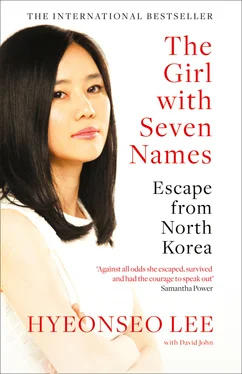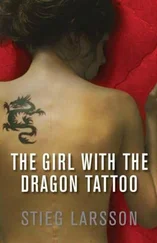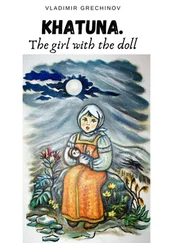She was strict with me, and I was brought up well. She had high standards for everything. She taught me it was rude to bump into older people, talk too loudly, eat too quickly, and eat with my mouth open. I learned that it was vulgar to sit with my legs apart. I learned to sit on the floor with my legs folded and tucked underneath, Japanese-style, and my posture bolt upright. She taught me to say goodbye to her and my father in the mornings with a full, ninety-degree bow.
When one of my girl friends dropped by once and saw me do this, she said: ‘What d’you do that for?’
The question surprised me. ‘You don’t do it?’
My friend became weak with laughter. I was teased after that with extravagant, mock-formal bows.
In the house my mother hated untidiness and could be obsessively orderly. In public she always looked her best – she never wore old clothes and had an eye for the fashion trends, although she was seldom satisfied with her appearance. In a society where round-faced women with large eyes and almond-shaped lips are considered beautiful, she bemoaned her narrow eyes and angular face, usually in a way that made fun of herself: ‘When I was pregnant I was worried you’d look like me.’ I acquired my liking for fashion from her.
I was expecting to start kindergarten in Hyesan, but it was not to be. One evening in December my father returned home from work grinning broadly. It was snowing hard outside and his cap and uniform were powdered white. He clapped his hands together, asked for some hot tea, and told us he had received a promotion. He was being transferred. We were moving to Anju, a city near North Korea’s west coast.
Chapter 3
The eyes on the wall
At the beginning of 1984, the three of us arrived in Anju. I was five years old. My mother’s heart sank when she saw the place. The region’s main industry is coal mining, and the Chongchon River, which runs through the city centre to the Yellow Sea, was black with silt and coal slag. We were informed that it smelled badly in summer and was prone to flooding the city in the rainy season. As with other cities in North Korea, much of Anju was rebuilt after the Korean War. All share a similarly drab, colourless look. Concrete blocks of flats lined the main roads in the centre. There were a few Soviet-style state buildings and a public park with the obligatory bronze statue of Kim Il-sung. Squat, tiled-roof houses made up the rest of the city. Hyesan, it has to be said, was not much different, but the mountain backdrop and our colourful family life there made it a magical place to us.
My mother had severe regrets about leaving Hyesan, knowing that she would not be able to visit her mother and siblings easily or often, but at the same time she knew that we were leading a privileged life. Most North Korean families never got to go anywhere. They stayed in the same place all their lives and needed a travel permit even to leave their local county. My father’s job gave him access to goods most other people didn’t have. We ate fish or meat with most meals. I did not know then that many North Koreans ate fish or meat so seldom that they could often remember the dates on which they did so – usually the birthdays of the Leaders, when extra rations were distributed.
We did not like our new house, which was on my father’s military base. It had a wall-mounted radio with a speaker. It could not be turned off, and had no volume control, and would occasionally blast instructions and air-raid drill announcements from the banjang – the head of our neighbourhood people’s unit. The banjang was usually a woman in her fifties whose job it was to deliver warnings from the government, check that no one was staying overnight without a permit, and to keep an eye on the families in her block. The day we moved in she presented us with the two portraits for our home. These were identical to the portraits in our house in Hyesan, and we hung them on the wall before we’d even eaten our first meal there.
Our entire family life, eating, socializing and sleeping, took place beneath the portraits. I was growing up under their gaze. Looking after them was the first rule of every family. In fact they represented a second family, wiser and more benign even than our own parents. They depicted our Great Leader Kim Il-sung, who founded our country, and his beloved son Kim Jong-il, the Dear Leader, who would one day succeed him. Their distant, airbrushed faces took pride of place in our home, and in all homes. They hung like icons in every building I ever entered.
From an early age I helped my mother clean them. We used a special cloth provided by the government, which could not be used for cleaning anything else. Even as a toddler I knew that the portraits were not like other household items. Once, when I pointed a finger at them, my mother scolded me loudly. ‘Never do that.’ Pointing, I learned, was extremely rude. If we needed to gesture towards them, we did so with the palm of the hand facing upward, with respect. ‘Like this,’ she said, showing me.
They had to be the highest objects in the room and perfectly aligned. No other pictures or clutter were permitted on the same wall. Public buildings, and the homes of high-ranking cadres of the Party, were obliged to display a third portrait – of Kim Jong-suk, a heroine of the anti-Japanese resistance who died young. She was the first wife of Kim Il-sung and the sainted mother of Kim Jong-il . I thought she was very beautiful. This holy trinity we called the Three Generals of Mount Paektu.
About once a month officials wearing white gloves entered every house in the block to inspect the portraits. If they reported a household for failing to clean them – we once saw them shine a flashlight at an angle to see if they could discern a single mote of dust on the glass – the family would be punished.
Every time we took them down for cleaning we handled them with extreme caution, as if they were priceless treasures from Koryo tombs, or pieces of enriched uranium. Damage to them due to humidity, which could make spots of mould appear on the paper in summer, was acceptable. Damage from any other cause could get a homeowner into serious trouble. Each year, stories of portrait-saving heroics would be featured in the media. My parents would hear a radio report commending a grandfather who’d waded through treacherous flood water holding the portraits above his head (he’d saved them, but sacrificed his own life in the attempt), or see a photograph in the Rodong Sinmun, the national daily, of a couple sitting precariously on the tiled roof of their hut after a catastrophic mudslide, clutching the sacred portraits. The newspaper exhorted all citizens to emulate the example of these real-life heroes.
This intrusion of the state into our home did not seem oppressive or unnatural to me. It was unthinkable that anyone would complain about the portraits. On the biggest dates in the calendar – the birthdays of Kim Il-sung and Kim Jong-il – the three of us would line up in front of them and make a solemn bow.
That small family ceremony was the only time politics entered our house. When my father came home from work, and the table was laid with rice, soup, kimchi and pickles, which we ate with every meal, my mother waited for me to say: ‘Thank you, Respected Father Leader Kim Il-sung, for our food’ before we picked up our chopsticks. But over dinner my parents chatted only of personal matters, or family. There was usually plenty of innocuous family news from Hyesan to talk about.
Serious topics were never discussed. I learned to avoid them in the way children acquire a sense for the dangers of the road. This was for my own protection, and we were no different from other families in that respect. Since there was no aspect of life, public or private, that fell outside the authority of the Party, almost every topic of conversation was potentially political, and potentially dangerous. My parents would not risk an incautious remark that might be repeated innocently by me, or misunderstood.
Читать дальше












